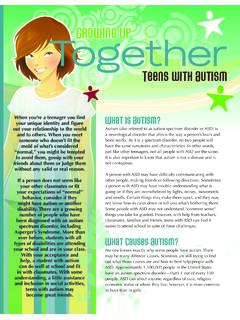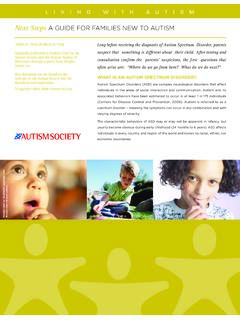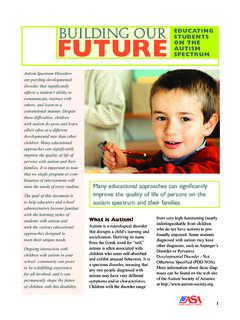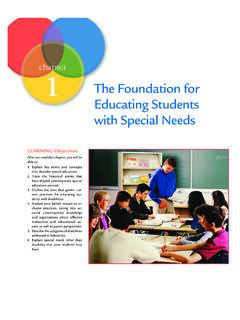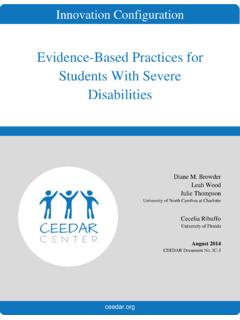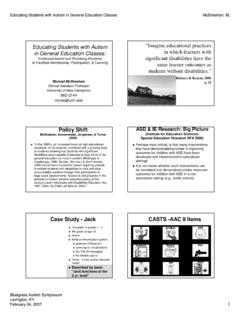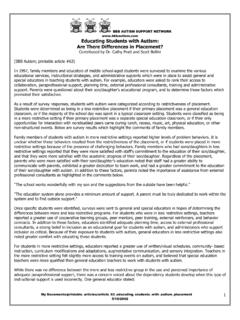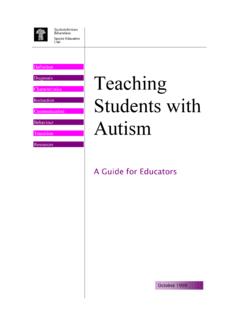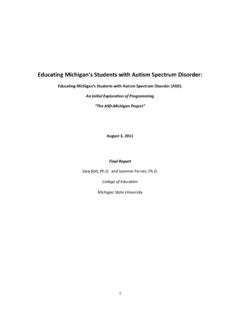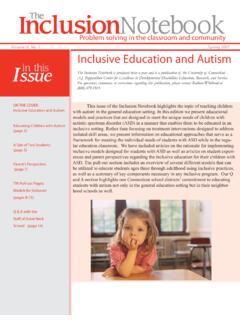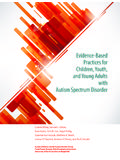Transcription of Building Our Future Educating StudEntS on thE SpEctrum
1 1 Building Our Future Educating StudEntS on thE SpEctrumMany educational approaches can significantly improve the quality of life of persons on the autism SpEctrum and their families. Acknowledgements: the autism society wishes to thank the following professionals for their contributions to the content of this booklet: Margaret Creedon, , Easter Seal Therapeutic Day School Andrew Egel, , Professor of Education, University of Maryland David L. Holmes, , President/Executive Director, Eden Family of Services Gary B. Mesibov, , Director/Professor, Division TEACCH, University of North Carolina Cathy L. Pratt, , Director, Indiana Resource Center for autism Frank Robbins, , Director, Quabbin Valley Educational Consultants Eric Schopler, , Founder/Professor, Division TEACCH, University of North Carolina LIVING wIth AutIsmWhat is autism ?
2 autism is a neurological disorder that disrupts a child s learning and socialization. deriving its name from the greek word for self, autism is often associated with children who seem self-absorbed and exhibit unusual behaviors. It is a SpEctrum disorder, meaning that any two people diagnosed with autism may have very different symptoms and/or characteristics. children with the disorder range from very high-functioning (nearly indistinguishable from children who do not have autism ) to profoundly impaired. some StudEntS diagnosed with autism may have other diagnoses, such as Asperger s disorder or Pervasive developmental disorder - not otherwise specified (Pdd-nos). more information about these diagnoses can be found on the web site of the autism society at autism is the third most common developmental disability, following mental retardation and cerebral palsy; it is four times more prevalent in boys than in girls.
3 The centers Images used for illustration purposes only. Models may not have educational approaches can significantly improve the quality of life of persons on the autism SpEctrum and their families. autism checklist Insistence on sameness; resists changes in routine s evere language deficits d ifficulty in expressing needs; uses gestures or pointing instead of words echolalia (repeating words or phrases in place of normal, responsive language) l aughing, crying, or showing distress for reasons not apparent to others Prefers to be alone; aloof in manner t antrums; displays extreme distress for no apparent reason d ifficulty in mixing with others m ay not want to be touched or may not be physically affectionate l ittle or no eye contact Unresponsive to standard teaching methods s ustained odd play s pins objects Inappropriate attachment to objects Apparent oversensitivity or undersensitivity to pain n o real fear of dangers n oticeable physical overactivity or extreme underactivity n ot responsive to verbal cues; acts as if deaf even though hearing tests in normal range Uneven gross/fine motor skills (may not kick a ball, but can stack blocks) Please note this symptom list is not a substitute for a full-scale diagnostic assessment.
4 For disease control and Prevention now estimates that one in every 175 children born in the today will fall somewhere on the autism SpEctrum . It is estimated that 1,500,000 people in the today have autism . autism is usually diagnosed during the first three years of a child s life. there is no medical test for autism ; a diagnosis is determined by a team of professionals through observation and testing of the child, coupled with interviews with parents or guardians. this diagnostic team may include a neurologist, psychologist, developmental pediatrician, speech/language pathologist, and/or other professionals knowledgeable about autism . the team s findings are then compared to the definitive protocol for assigning a diagnosis of autism as set forth in the dsmIV-tR (diagnostic and statistical manual for mental disorders Fourth edition text Revision), published by the American Psychiatric Association.
5 For a diagnosis to be made, a child must exhibit some symptoms in all of the three following categories, although the level of severity can vary greatly: 1. Qualitative impairments in social interaction. StudEntS with autism may have great difficulty developing peer relationships appropriate to their developmental level. many may have difficulties understanding social cues or rules, participating in community or leisure activities, or relating to others. 2. Qualitative impairments in communication. StudEntS with autism may have difficulty understanding spoken language or reading nonverbal communications, such as facial expressions or gestures. some speak in odd or unconventional Restrictive, repetitive, and stereotyped patterns of behavior, interests, and activities. StudEntS with autism may have unusual preoccupations, odd or repetitive motor mannerisms, and/or restricted patterns of interest that are abnormal in either intensity or focus.
6 Difficulty in processing sensory input may cause some of these children to have unusual reactions to sounds, sights, touch, or smells. 3 Frequently, children with Asds exhibit uneven development in cognitive, communications, social, adaptive, and motor skills. sometimes significant strengths in isolated skills are coupled with significant deficits in others. like other children, they respond to their environment in positive and negative ways. Although autism may affect their range of responses and may make it more difficult to control how their body and mind react to everyday situations, people with Asd live normal life spans and certain associated behaviors may change or disappear over time. other disorders can coexist with autism , such as seizure disorders, mental retardation, or obsessive-compulsive disorder. scientists and researchers are exploring a number of theories regarding the causes of autism .
7 Unfortunately, to date, no single cause or cure has been identified. What autism is not contrary to popular belief, some children and adults with autism do express affection, smile and laugh, and show a variety of other emotions, but in varying degrees. Although children with Asd are often described as being aloof or self-absorbed, many of them would like to have friends. However, the very nature of their disability makes it difficult for them to establish or maintain the basic peer relationships that ultimately develop into friendships. autism is not the result of poor parenting children with autism are not unruly or spoiled kids with just a behavior problem the vast majority of persons with autism are not savants, like the character portrayed by dustin Hoffman in the movie Rain Man children with autism are not without feelings and emotions differences among children With autism the most notable differences among children with Asd involve their use of language to communicate.
8 Higher functioning individuals, including those diagnosed with Asperger s disorder, are able to communicate quite well verbally (although sometimes they may speak or use language in odd or peculiar ways). others talk very sparingly, and some never speak. those without spoken language will often use a picture-based communication system or some other augmentative communication device to help in expressing themselves. the inability to communicate effectively or to understand conventional communication can become a significant barrier to a child s ability to learn and to adapt to community settings. some StudEntS with Asd are quiet and passive, while others may be hyperactive and/or insistent. most will require strict adherence to schedules and routines, although a few will accept changes without incident. the interpretation of sensory input can vary greatly among children with autism .
9 They may be hypersensitive to sounds or touch, have an unusually high threshold for pain, or perhaps crave constant, deep pressure. most will exhibit unusual behaviors, but these will differ from individual to individual. For instance, one child may do odd things with her eyes, while another child may rock his body or repeat the same words or phrases over and over. autism and intelligence tests of adaptability and intelligence indicate that many children with autism have some level of mental retardation. despite this, some people with autism have average to above average intelligence. A few have superior IQs. individuals With disabilities education act the Individuals with disabilities education Act (IdeA) ensures that all children with disabilities receive a free, appropriate public education in the least restrictive environment, tailored to each child s individual needs.
10 This law guarantees all children, regardless of their abilities, the right to obtain educational benefits from their educational setting. As autism affects approximately 1,500,000 individuals in the , and proper implementation of this law is of utmost importance to many families and to the education community at large. For children with autism , it is particularly important to provide opportunities to learn through a variety of educational options - from typical school settings to more specialized settings. although children With autism are often described as being aloof or self-absorbed, many of them Would like to have friends. 4the individualized education program no matter the level of disability, the educational program for an individual with autism must be based on the unique needs of that person. to help determine what sort of learning environment would be best for a person with autism , an Individualized education Program (I eP) should be developed.

